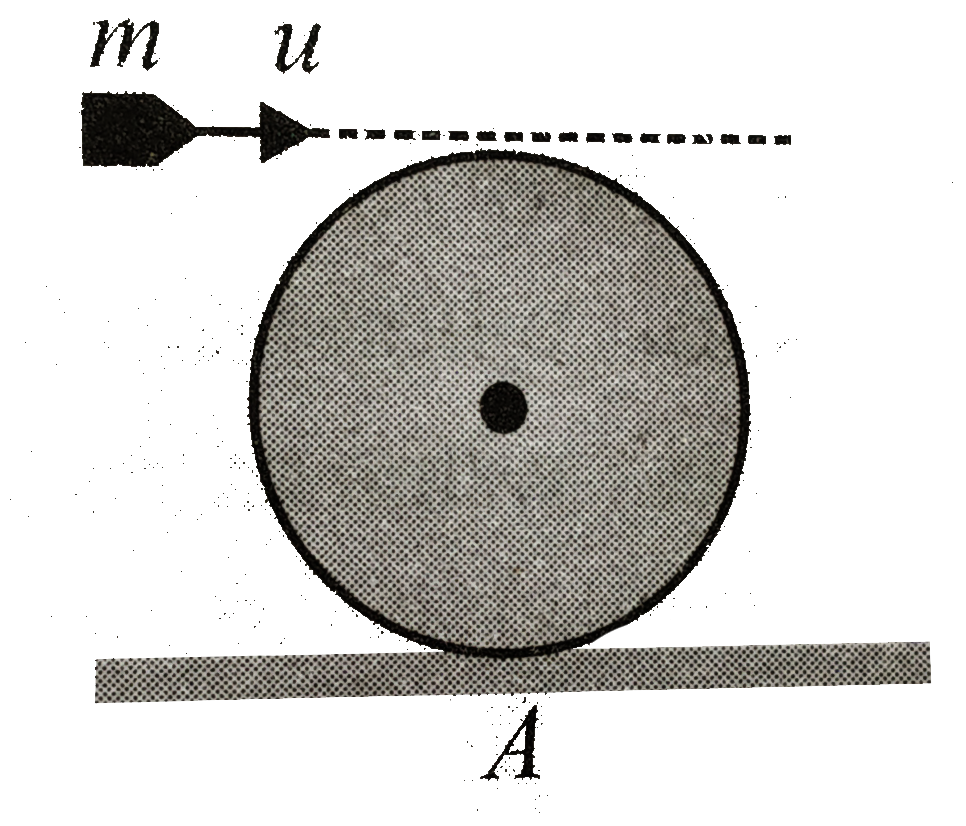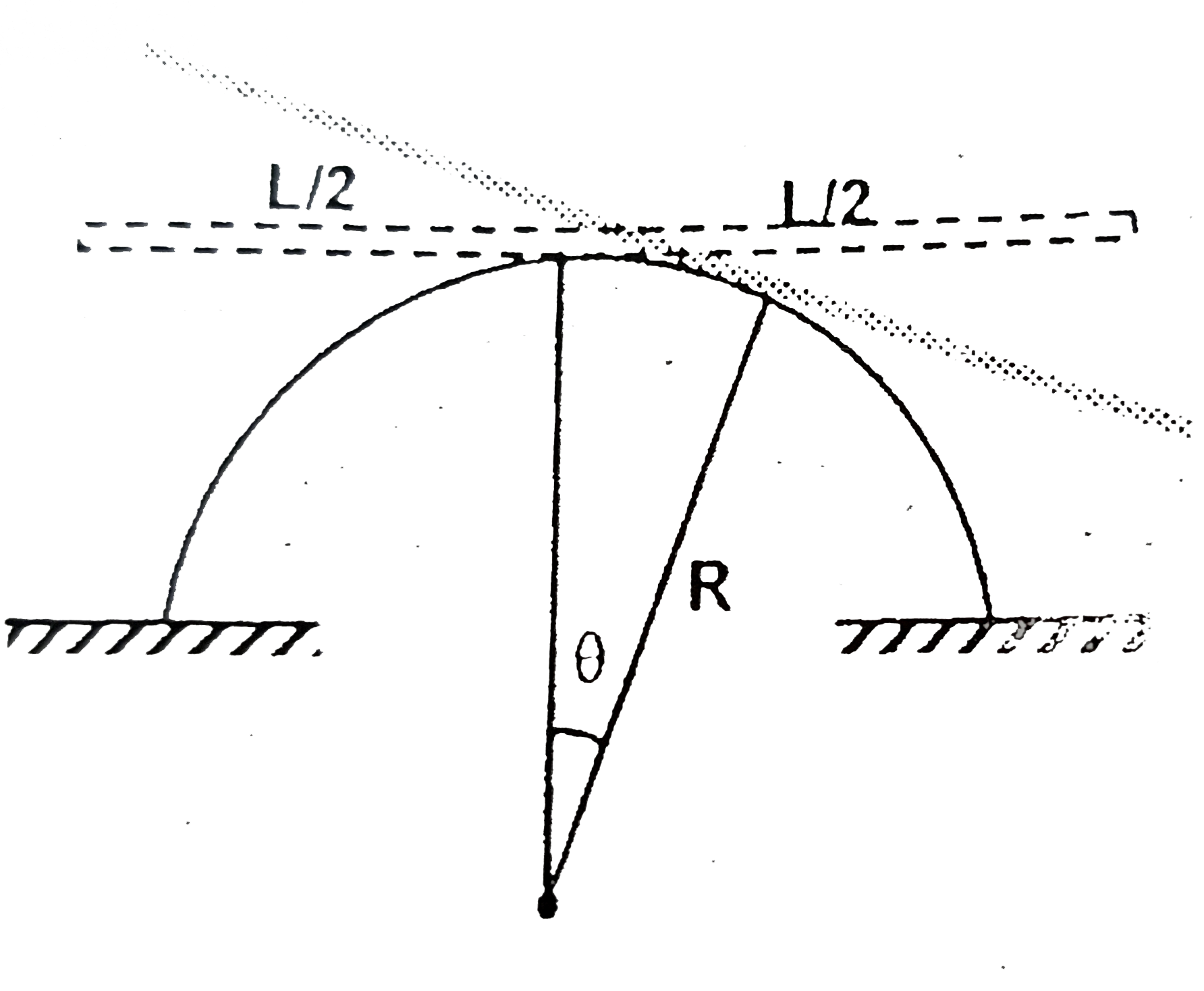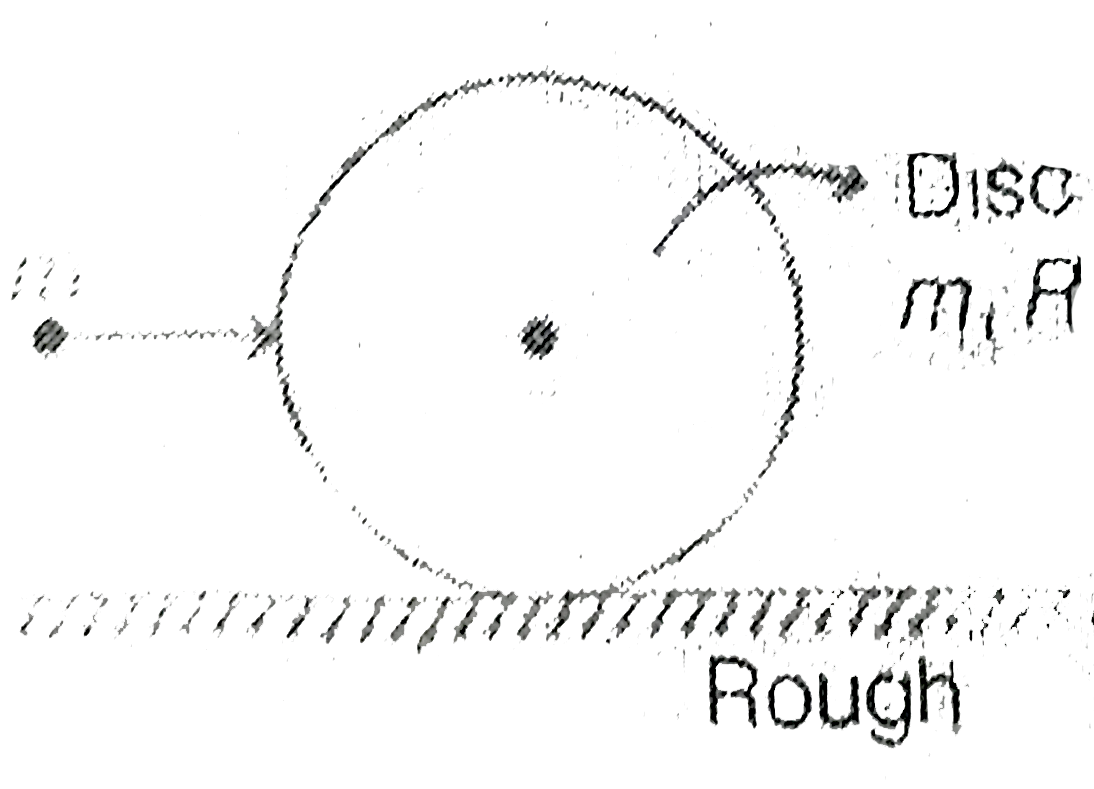A carpet of mass M is rolled along its length so as to from a cylinder of radius R and is kept on a rough floor. When a negligibly small push is given to the cylindrical carpet, it stars unrolling itself without sliding on the floor. Calculate horizontal velocity of cylindrical part of the carpet when its radius reduces to R/2.
To solve the problem, we will use the principles of conservation of energy and the relationship between translational and rotational motion for a rolling object.
1. Understanding the System:
- We have a carpet of mass M rolled into a cylinder of radius R.
- When the radius reduces to R2, we need to find the horizontal velocity V of the cylindrical part.
2. Finding the Mass of the Remaining Carpet:
- The area of the carpet when the radius is R is proportional to R2.
- When the radius is reduced to R2, the area becomes (R2)2=R24.
- Thus, the mass of the remaining carpet is M4.
3. Calculating Potential Energy:
- Initial potential energy when the radius is R:
PEi=MgR
- Final potential energy when the radius is R2:
PEf=M4g(R2)=MgR8
4. Change in Potential Energy:
- The change in potential energy as the carpet unrolls:
ΔPE=PEi−PEf=MgR−MgR8=7MgR8
5. Using Conservation of Energy:
- The change in potential energy is converted into kinetic energy (both translational and rotational).
- The total kinetic energy when the radius is R2 can be expressed as:
KE=KEtranslational+KErotational
- Translational kinetic energy:
KEtranslational=12(M4)V2=MV28
- The moment of inertia I for a cylinder is 12mR2. For the remaining mass M4 at radius R2:
I=12(M4)(R2)2=MR232
- Rotational kinetic energy:
KErotational=12Iω2=12(MR232)⎛⎝VR2⎞⎠2=MV232
6. Setting Up the Energy Equation:
- Equating the change in potential energy to the total kinetic energy:
7MgR8=MV28+MV232
- Simplifying the right-hand side:
MV28+MV232=4MV232+MV232=5MV232
- Thus, we have:
7MgR8=5MV232
7. Solving for V2:
- Cancel M from both sides:
7gR8=5V232
- Rearranging gives:
V2=7gR×328×5=28gR5
8. Finding V:
- Taking the square root:
V=√28gR5=2√7gR√5
Final Answer:
The horizontal velocity of the cylindrical part of the carpet when its radius reduces to R2 is:
V=√28gR5
- We have a carpet of mass M rolled into a cylinder of radius R.
- When the radius reduces to R2, we need to find the horizontal velocity V of the cylindrical part.
- The area of the carpet when the radius is R is proportional to R2.
- When the radius is reduced to R2, the area becomes (R2)2=R24.
- Thus, the mass of the remaining carpet is M4.
- Initial potential energy when the radius is R:
PEi=MgR
- Final potential energy when the radius is R2:
PEf=M4g(R2)=MgR8
- The change in potential energy as the carpet unrolls:
ΔPE=PEi−PEf=MgR−MgR8=7MgR8
- The change in potential energy is converted into kinetic energy (both translational and rotational).
- The total kinetic energy when the radius is R2 can be expressed as:
KE=KEtranslational+KErotational
- Translational kinetic energy:
KEtranslational=12(M4)V2=MV28
- The moment of inertia I for a cylinder is 12mR2. For the remaining mass M4 at radius R2:
I=12(M4)(R2)2=MR232
- Rotational kinetic energy:
KErotational=12Iω2=12(MR232)⎛⎝VR2⎞⎠2=MV232
- Equating the change in potential energy to the total kinetic energy:
7MgR8=MV28+MV232
- Simplifying the right-hand side:
MV28+MV232=4MV232+MV232=5MV232
- Thus, we have:
7MgR8=5MV232
- Cancel M from both sides:
7gR8=5V232
- Rearranging gives:
V2=7gR×328×5=28gR5
- Taking the square root:
V=√28gR5=2√7gR√5
The horizontal velocity of the cylindrical part of the carpet when its radius reduces to R2 is:
V=√28gR5
Topper's Solved these Questions
- RIGID BODY DYNAMICS 2BOOK - CENGAGE PHYSICS ENGLISHCHAPTER - RIGID BODY DYNAMICS 2EXERCISE - Exercise 3.1
11 Videos
- RIGID BODY DYNAMICS 2BOOK - CENGAGE PHYSICS ENGLISHCHAPTER - RIGID BODY DYNAMICS 2EXERCISE - Exercise 3.2
13 Videos
- RIGID BODY DYNAMICS 2BOOK - CENGAGE PHYSICS ENGLISHCHAPTER - RIGID BODY DYNAMICS 2EXERCISE - Interger
2 Videos
- RIGID BODY DYNAMICS 1BOOK - CENGAGE PHYSICS ENGLISHCHAPTER - RIGID BODY DYNAMICS 1EXERCISE - Integer
11 Videos
- SOUND WAVES AND DOPPLER EFFECTBOOK - CENGAGE PHYSICS ENGLISHCHAPTER - SOUND WAVES AND DOPPLER EFFECTEXERCISE - Integer
16 Videos
Similar Questions
A floor-mat of mass M made up of extensible material, is rolled along its length so as to form a cylinder of radius R and kept on a rough horizontal surface. If the mat is now unrolled, without sliding, to a radius R2, the decrease in potential energy is
View SolutionA solid cylinder of mass M and radius R rolls without slipping on a flat horizontal surface. Its moment of inertia about the line of contact is
View Solution
Knowledge Check
A floor-mat of mass M made up of extensible material, is rolled along its length so as to form a cylinder of radius R and kept on a rough horizontal surface. If the mat is now unrolled, without sliding, to a radius R2, the decrease in potential energy is
A1. 12MgRB2. 78MgRC3. 58MgRD4. 34MgRA particle of mass M is moving in a horizontal circle fo radius R with unifomr speed V. When it moves from one point to a diameterically opposite point, its
Akinetic energy change by MV2/4Bmomentum does not changeCmomentum changes by 2 MVDkinetic energy changes by MV2
A bullet of mass m moving with a velocity of u just grazes the top of a solid cylinder of mass M and radius R resting on a rough horizontal surface as shown and is embedded in the cylinder after impact. Assuming that the cylinder rolls without slipping, find the angular velocity of the cylinder and the final velocity of the bullet.

View SolutionA cylinder of mass m and radius R is kept on a rough surface after giving its centre a horizontal speed v0. Find the speed of the centre of the cylinder when it stops slipping.
View SolutionA uniform rod of maass m and length L is placed on the fixed cylindrical surface of radius R at an small angular position θ from the vertical (vertical means line joining centre and vertex of the cylindrical path) as shown in the figure and released from rest. Find the angular velocity ω of the rod at the instant when it crosses the horizontal position (Assume that when rod comes at horizontal position its mid point and vertex of the circular surface coincide). Friction is sufficient to prevent any slipping.

View SolutionA particle of mass m moves along the internal smooth surface of a vertical cylinder of the radius R. Find the force with which the particle acts on the cylinder wall if at the initial moment of time its velocity equals v0. And forms an angle α with the horizontal.
View SolutionA wheel ( to be considered as a ring ) of mass m and radius R rolls without sliding on a horizontal surface with constant velocity v. It encounters a step of height R/2 at which it ascends without sliding

View SolutionA point mass m collides with a disc of mass m and radius R resting on a rough horizontal surface as shown . Its collision is perfectly elastic. Find angular velocity of the disc after pure rolling starts

View Solution
